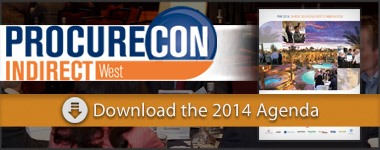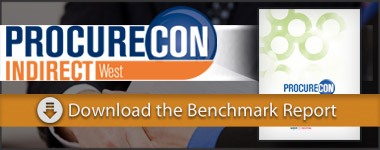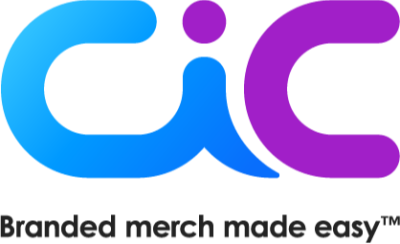Reduce Procurement Transaction Costs
Bill McNally discusses the unique sourcing selection and procurement environment of NASA.
Video Transcript
Bill McNally: So I got to transform myself–I think I’m the only federal buyer here, so I’m going to transform NASA into a part of a company. Big corporation is the federal government. You are shareholders of it, thank you for your tax money. And the one thing to understand is hopefully your companies don’t run fiscally like my corporation. Like when they shut down for a couple of weeks and–or partially shut down. But so what I want to is frame a–one of the profit centers for the corporation Federal Government NASA and what I’m trying to do along with many others at NASA is to reduce our transaction cost which I don’t think we really had looked at in order to get more work done for the budget. Our budget is not going to go down if we have savings. What we will be able to do is be able to do more work, mission work that will support you, the shareholders of what we can do at NASA for you. So I got that figured out. So what does NASA do? Here are our product lines.
The first product line is Aeronautics. About $400 million a year we spend doing various aeronautics research that could be new engines for the airlines, more fuel efficient green technologies in those areas, sound technologies, we do modeling as far as how airports, new airports, could get structure, where should they be located within a location. So we team up with a lot of other government organizations, team up with industry to look at how do we advance the area of the aeronautics. The next area which is really one that you’ve all seen with, you know, in previously had a product line called the Space Shuttle Program. That product line ended but that provided human exploration that we did building a platform that we have right now on lower orbit called the International Space Station. That platform does a lot of various type of research. It’s very expensive to keep up there. You probably have heard about when we have to go out and fix it outside in space. It’s not like that movie, whatever that movie with Sandra Bullock, not like Gravity, but a little bit going out there performing those type of operations is high risk and expensive. So but right now the International Space Station is targeted to stay up there until 2024. So now I need to have a transportation system which I have in place two companies that I’m under contract with to provide cargo to and from the International Space Station and what they do is they bring up cargo or experiments and then bring back results of experiments to the ground. The next area talking about weather is Science. We do science in near Earth. We have a program joint polar system to set up a more predictive weather system for the United States and unfortunately right now the European model us probably more predictive or better predictive but we’re trying to set up a system of satellites to be able to do better weather prediction and then we also do deep space and if you noticed about a year ago we landed on Mars and now we have a Rover running around Mars doing varied types of operational research on Mars. And then we have a new product line, Space Technologies that will feed in to all these other areas where we look at certain technologies like a new engine that will get us to Mars quicker than the eight-month time period takes us right now. So and then finally that I don’t have listed here is the indirect area of mission support which I fall under that does the procurement, human capital, information technology.
All the areas of indirect that support these product lines. Here is how we’re mapped as far as location where we do operations. I got 10 buy-in organizations and I do have a shared service center that performs HR, financials, some IT and certain buy-in transactions for the agency instead of having it done by 10 separate buy-in offices or 10 separate human capital offices. So we’ve set up this shared service center. I think it’s a model that the federal government, my corporation, is going to be moving towards and to me it just makes a lot of practical sense to try to set up a common organization to do transactional things safe for the federal government. So here is the scenario, the budget is going down, right? This fiscal year, the budget for NASA is $17.6 billion. Actually, that was a pretty good budget number. It took us a while to get that budget but finally we got the budget for FY14. It’s not exactly what we asked for but it’s what we got. It’s less than what we got a couple of years ago and if you think some of the products that NASA have. I have a–I’m responsible for contracts that I have contracts for $8 billion and then I have a purchased card transactions. So my transactions are pretty big spend. Those $8 billion contacts span 8 to 10 years. So one of the challenges is trying to be predictive in getting the budget you need every year to fit in to that $8 billion contract and that’s a big challenge that we have and it’s a big risk area that we have. So a little bit difference that I can see between federal contracting and commercial contracting, one is I’ve got probably more regulations than you have to–that you put in your contract. But the good thing from a contracting perspective, I have one regulation called the Federal Acquisition Regulation. Now I have a supplement from my agency that I try to keep to minimum but I already have one termination for convenience clause.
I have one termination for default clause. There is–I have one payment arrangement that they all–so it’s actually a very good efficient way to do business when you’re filing your billion dollar corporation. So this way if you’re doing business with the government, you pretty much know what areas you have to be compliant with and you don’t have to worry about understanding 7 different clauses in termination for convenience. There is only one. The other thing, though, is that makes it challenging is I got a lot of non-firm fixed price contracts. In NASA we have about 70% of our spend is non-firm fixed price so that brings a clause risk to me because the contractor is performing and we’re trying to understand how well their schedule is going to the spend and, of course, if they are overrunning, I either have to change the work or feed more money into the contract and that’s a huge cost risk, which many of you don’t face. You set up your contracts, firm fixed price, company has to deliver. The other thing is the companies who do business with me could face scrutiny during the life of the contract. The healthcare debacle, you know what the website and the different companies. Well, no those companies, those who did that work are public, you know, probably not good for their public image and so and then the company has the work now they start revealing some of the problems they have. So if you do business with the government you face some public scrutiny in doing that work. The other thing that’s different is I run source selections, you know, competitions. I only can pick one company then I have a few companies that don’t win. I try to explain why they don’t, you know, why they didn’t win. Sometimes they want to sue me, so that’s what you call the protest. Yesterday, I got one. You know, getting an e-mail. I got a protest. Company’s not happy. They didn’t–you know, win a contract. So again, we go through that process, you probably don’t have to do that in the commercial. Unless you do something legally they want to take you to court on. But all these things are cost to me. And so here some of the areas that I started looking at and trying to measure of the cost of doing business. One is when selecting our vendors. When I’m trying to really be–I’m very–I believe NASA is very effective in selecting the vendors. We usually pick the best vendor, good competitive price. They usually know exactly what they’re supposed to do and that’s how I am able to achieve some of those high performing risk missions that I have to do, but one of the things that I have noticed over the years of running procurement at NASA, we are not as efficient. We’re asking for too much data from companies. So what we’re trying to do is be more efficient in our source selection process. Because one of the things that the government pays for as your cost that companies have for preparing proposals. It’s called bid and proposal cost. It’s part of a company’s overheads. So if you’re doing business with the government, you’ll get that cost back as part of the overhead cost when you have contracts with me. So what I’m trying to do is reduce the B&P cost that companies have to spend to do business with NASA which hopefully will drive maybe overhead costs to go down or allow companies more opportunities to bid on more jobs.
The other area is, because some of my work is a little bit unsure or unknown, we have contracts that are IDIQ – indefinitive indefinite quantities. So to get worked on I issue task orders while I’m paying for those task order proposals. And so what I’m trying to do is put more of the work back into the contract and get away from writing a lot of task orders. In that way there is more money towards the mission work and less money towards the transaction cost, I’m getting that work done. We spend an enormous amount of time on incremental funding actions. We see them every month where we’re funding a contract and again, that’s a transaction cost that is a little bit invisible to me but it’s taking up time of my personnel and also the time of the companies who are doing business with me.
So and then the last thing is just an example of license. A lot of you have this in your big company where instead of having an enterprise license agreement, some entities like to go off and buy their own software license which that does is drive up higher cost plus put you in a legal situation of whether or not people aren’t following license or, you know, put you in a risk of litigation.
So NASA’s high risk environment, declining budget, so what was my approach to attack the transaction cost. First of all, what I did was I sat down with all my procurement officers and talked about the areas I mentioned. The source selection process, the task orders that we were doing, incremental funding actions and various others to have them identify the transaction cost areas that they thought they were facing. Put out letter to all of them, each one of them, not individually, one letter and to go over the areas of reducing transaction cost. I wanted them to absorb it and start communicating within their organization. Then I brought it up to my CEO which is the administrator for NASA and talked to him about it, had him sent out a memo to all the officials in charge that report to him where he endorsed the memo that I put out and personally wrote a note about reducing transaction cost. So we’ve been on this journey for about a year and one of the things I do is I go to every center at least once a year and I sit down with the Center Director and all the procurement people industry and we spend about 30 minutes about reducing transaction cost, which areas do we still have to hit. Because this is an area that–what you don’t want to do is try to reduce cost, transaction cost but then risk not having missions done properly because one of the things I can’t afford not to have a mission accomplished effectively because then I’ve spent maybe billions of dollars and not get the information I need from that mission.
So again, we’re trying to lean out what’s the right way to do source selections. I’ve had a lot of training in this area to do new types of source selection approaches like instead of looking at the technical approach, management approach, past performance and price of a company, some of that work, we’re just looking at the past performance and the price. It’s called Price Performance Trade-off. It takes away a lot of information companies have to propose because some of my work, I really don’t need to see the approach. I have a pretty much, you know, do my security work. I’m out looking for new technologies and it’s basically I just need to know that the company can do that based on looking at their prior contract work. How well do they perform? And then price. The other thing I’m looking at is the process–I’m really looking at lead time. I have a team that’s been working for the last 4 months on measuring the lead time on source selections which is a big driver of cost–transaction cost and time. And we’re looking to see how long it’s been taking from different mile stones and trying to find out, okay, how can–what action can be done to reduce the lead time of cost. A, it’s costing the industry money the longer procurement takes and secondly it’s costing me internally time the longer procurement takes. So we’re looking at making things more affordable and including that is transaction cost. I’ve got to have the right skill people. A lot of you have talked continually about what type of people do you have.
So we have a certification process in the federal government for contracting people but I’m going beyond certified, you know, people who have certified–certifications. I’m looking for competencies. So we’re looking at what type of work they have to do, what skills do they need and I’m supplementing as much of the workshops capabilities to help these people. Give them the right tools so they can be a competent workforce. Again, if 70% of my work is non-firm fixed price, some of it is sole source, I got to really have good analyst who know how to go–go into a proposal, rip it apart, sit down with the vendor and really get down into negotiation. So that’s the area of cost price analysis improvement projects that we’re working very hard on. And last, I’ll wrap up is I heard about supplier diversity, well I have to have so much of my contracts with small business. I get a goal every year and the goal–even though my budget goes down, my goal goes up which makes it challenging to get a work into small business because a lot of the work NASA does is going to be with large businesses based on the type of work we do but we work really hard not only at the prime contract level, but the subcontract level in getting as much work as we can into small businesses. And of course timely award of contract actions. Time is money and what I’m trying to do is reduce the lead time in our procurements. Communications with the industry is really important. I put out a communications plan that I share with the industry. I need to tell you what’s going on with our requirements. What’s going on with our actions? I need to be transparent as possible and what will do, first of all they will invite industry to want to bid on NASA work but secondly if you don’t win NASA job, hopefully you’ll just go away and look for the next job and you don’t sue me. And then the last thing is reduction of cast is cross agency support. That’s like procurement cost indirect and so that budget is kind of going down, so I got a little–to still support the agency and that’s really a paramount that I reduce transaction cost. So I can, you know, work harder–get way from just working harder but working smarter. So basically, thank you. Hopefully as a federal buyer you kind of understood what I’m doing at NASA as part of the big corporation federal government. Hopefully you’re happy shareholders, at least for what NASA provides you and I will be part of a booth table later if you got further questions.
[Applause]































